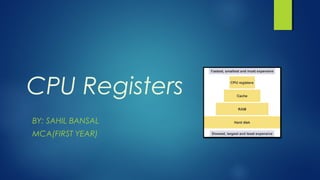
Registers
- 1. CPU Registers BY: SAHIL BANSAL MCA(FIRST YEAR)
- 2. Computer Registers A register is a very small amount of very fast memory that is built into the CPU (central processing unit) in order to speed up its operations by providing quick access to commonly used values. Small, permanent storage locations within the CPU used for a particular purpose Manipulated directly by the Control Unit Wired for specific function Size in bits or bytes (not MB like memory) Can hold data, an address or an instruction
- 3. Use of Registers Scratchpad for currently executing program Holds data needed quickly or frequently Stores information about status of CPU and currently executing program Address of next program instruction Signals from external devices Registers are normally measured by the number of bits they can hold. Registers are used to store data temporarily during the execution of a program. Some of the registers are accessible to the user through instructions. Data and instructions must be put into the system. So we need registers for this.
- 4. Register basic Operations Fetch: The Fetch Operation is used for taking the instructions those are given by the user and the Instructions those are stored into the Main Memory will be fetch by using Registers. Decode: The Decode Operation is used for interpreting the Instructions means the Instructions are decoded means the CPU will find out which Operation is to be performed on the Instructions. Execute: The Execute Operation is performed by the CPU. And Results those are produced by the CPU are then Stored into the Memory and after that they are displayed on the user Screen.
- 5. Registers are divided in 5 major categories: General Purpose Registers Pointer Registers Index Registers Segment Registers Flag Registers
- 6. General Purpose Registers: There are four General Purpose Registers named as follows: 1. AX (Accumulator Register): commonly used for arithmetic & logic data transfer. 2. BX (Base Address Register): used to save the address of memory location. 3. CX (Count Register): keeps record of iterations while a LOOP instruction is running. 4. DX (Data Register): holds data of the instruction currently being executed.
- 7. Pointer Registers: There are three pointer registers that are used to point toward some memory address. BP (Base Pointer): points to the base element of the stack. SP (Stack Pointer): always points to the top element of the stack. IP (Instruction Pointer): stores the address of the next instruction to be executed.
- 8. Index Registers: Index registers are used for indexed addressing and sometimes also used in addition and subtraction. There are two sets of index registers: SI (Source Index): used as source index for string operations. DI (Destination Index): used as destination index for string operations.
- 9. Segment Registers: Segments are specific areas defined in a program for containing data, code and stack. There are three main segments: Code Segment: it contains all the instructions to be executed. Data Segment: it contains data, constants and work areas. Stack Segment: it contains data and return addresses of procedures or subroutines. It is implemented as a 'stack' data structure.
- 10. Flag Registers: These registers are programmable. It can be used to store and transfer the data from the registers by using instruction. The common flag bits are: Overflow Flag (OF) Direction Flag (DF) Interrupt Flag (IF) Trap Flag (TF) Sign Flag (SF) Auxiliary Carry Flag (AF) Parity Flag (PF) Carry Flag (CF)
- 11. Thank You